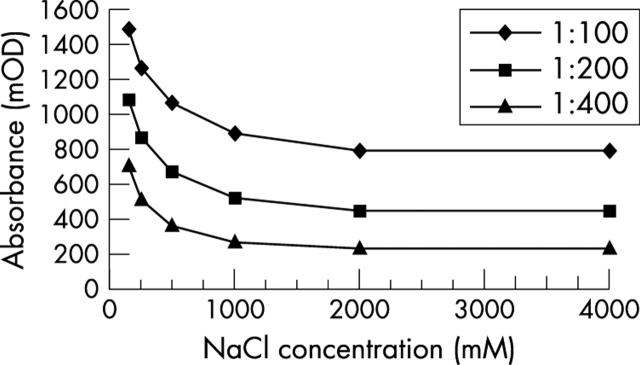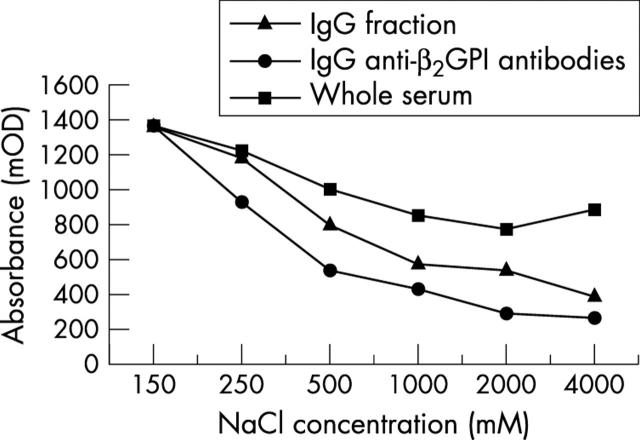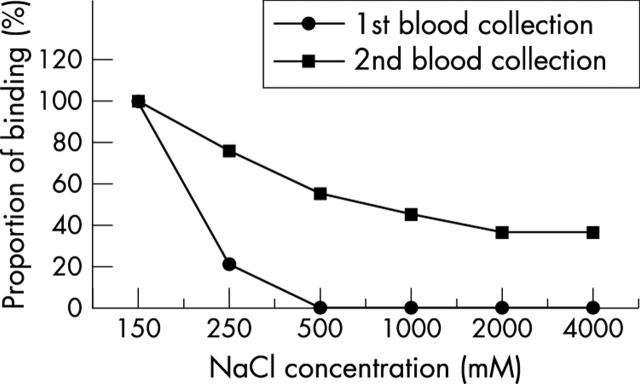Abstract
Objective: To evaluate avidity of IgG anti-ß2-glycoprotein I antibodies (anti-ß2-GPI) in patients with antiphospholipid syndrome (APS) and systemic lupus erythematosus (SLE) in relation to thrombosis, and to demonstrate a possible affinity maturation of IgG anti-ß2-GPI during the disease course.
Methods: 64 sera from 32 patients (18 with primary or secondary APS, 14 with SLE without APS) and their respective IgG fractions or affinity purified anti-ß2-GPI were studied by anticardiolipin (aCL) and anti-ß2-GPI enzyme linked immunosorbent assay and by chaotropic assay.
Results: Six, 12, and 14 patients had high, low, and heterogeneous avidity IgG anti-ß2-GPI, respectively. In 12 patients an increase in antibody avidity was observed over a period of between four and 12 years. More patients with APS were in the high avidity than in the low avidity anti-ß2-GPI group, while the opposite was observed for SLE alone (both p<0.05). The most common clinical feature among patients with high avidity anti-ß2-GPI was thrombosis, mainly venous thrombosis (p<0.05 and p<0.02, respectively, v the low avidity anti-ß2-GPI group).
Conclusions: Patients with APS with or without SLE may have anti-ß2-GPI of high, low, or heterogeneous avidity. High avidity anti-ß2-GPI appear to be associated with thrombosis and APS, while in pure SLE low avidity anti-ß2-GPI may prevail. Monitoring of avidity may help elucidate the role of anti-ß2-GPI affinity maturation in the pathogenesis of APS.
Full Text
The Full Text of this article is available as a PDF (126.5 KB).
Figure 1.
The example of high, heterogeneous, and low avidity anti-ß2-glycoprotein I antibodies.
Figure 2.
Avidity determination of anti-ß2-glycoprotein I antibodies in diluted serum. mOD: absorbance x1000.
Figure 3.
Effect of matrix on the detection of high avidity anti-ß2-glycoprotein I antibodies. mOD: absorbance x1000.
Figure 4.
The example of an affinity maturation of anti-ß2-glycoprotein I antibodies in paired samples from the same patient but different blood collections.
Selected References
These references are in PubMed. This may not be the complete list of references from this article.
- Altschul S. F., Lipman D. J. Protein database searches for multiple alignments. Proc Natl Acad Sci U S A. 1990 Jul;87(14):5509–5513. doi: 10.1073/pnas.87.14.5509. [DOI] [PMC free article] [PubMed] [Google Scholar]
- Arvieux J., Renaudineau Y., Mane I., Perraut R., Krilis S. A., Youinou P. Distinguishing features of anti-beta2 glycoprotein I antibodies between patients with leprosy and the antiphospholipid syndrome. Thromb Haemost. 2002 Apr;87(4):599–605. [PubMed] [Google Scholar]
- Avcin T., Ambrozic A., Bozic B., Accetto M., Kveder T., Rozman' B. Estimation of anticardiolipin antibodies, anti-beta2 glycoprotein I antibodies and lupus anticoagulant in a prospective longitudinal study of children with juvenile idiopathic arthritis. Clin Exp Rheumatol. 2002 Jan-Feb;20(1):101–108. [PubMed] [Google Scholar]
- Bakimer R., Fishman P., Blank M., Sredni B., Djaldetti M., Shoenfeld Y. Induction of primary antiphospholipid syndrome in mice by immunization with a human monoclonal anticardiolipin antibody (H-3). J Clin Invest. 1992 May;89(5):1558–1563. doi: 10.1172/JCI115749. [DOI] [PMC free article] [PubMed] [Google Scholar]
- Blank M., Shoenfeld Y., Cabilly S., Heldman Y., Fridkin M., Katchalski-Katzir E. Prevention of experimental antiphospholipid syndrome and endothelial cell activation by synthetic peptides. Proc Natl Acad Sci U S A. 1999 Apr 27;96(9):5164–5168. doi: 10.1073/pnas.96.9.5164. [DOI] [PMC free article] [PubMed] [Google Scholar]
- Bozic B., Kveder T., Stegnar M., Morosini-Berus E., Kos-Golja M., Peternel P., Rozman B. Influence of degraded phosphatidylserine on binding of antiphospholipid antibodies. Int Arch Allergy Immunol. 1997 Jan;112(1):19–26. doi: 10.1159/000237426. [DOI] [PubMed] [Google Scholar]
- Chukwuocha R. U., Hsiao E. T., Shaw P., Witztum J. L., Chen P. P. Isolation, characterization and sequence analysis of five IgG monoclonal anti-beta 2-glycoprotein-1 and anti-prothrombin antigen-binding fragments generated by phage display. J Immunol. 1999 Oct 15;163(8):4604–4611. [PubMed] [Google Scholar]
- Cucnik S., Ambrozic A., Bozic B., Skitek M., Kveder T. Anti-beta2-glycoprotein I ELISA: methodology, determination of cut-off values in 434 healthy Caucasians and evaluation of monoclonal antibodies as possible international standards. Clin Chem Lab Med. 2000 Aug;38(8):777–783. doi: 10.1515/CCLM.2000.111. [DOI] [PubMed] [Google Scholar]
- Cucnik Sasa, Krizaj Igor, Rozman Blaz, Kveder Tanja, Bozic Borut. Concomitant isolation of protein C inhibitor and unnicked beta2-glycoprotein I. Clin Chem Lab Med. 2004 Feb;42(2):171–174. doi: 10.1515/CCLM.2004.031. [DOI] [PubMed] [Google Scholar]
- De Baets M., Stassen M. H. W. The role of antibodies in myasthenia gravis. J Neurol Sci. 2002 Oct 15;202(1-2):5–11. doi: 10.1016/s0022-510x(02)00200-9. [DOI] [PubMed] [Google Scholar]
- Hochberg M. C. Updating the American College of Rheumatology revised criteria for the classification of systemic lupus erythematosus. Arthritis Rheum. 1997 Sep;40(9):1725–1725. doi: 10.1002/art.1780400928. [DOI] [PubMed] [Google Scholar]
- Kaufman E. N., Jain R. K. Effect of bivalent interaction upon apparent antibody affinity: experimental confirmation of theory using fluorescence photobleaching and implications for antibody binding assays. Cancer Res. 1992 Aug 1;52(15):4157–4167. [PubMed] [Google Scholar]
- Koike T., Matsuura E. Anti-beta 2-glycoprotein I antibody: specificity and clinical significance. Lupus. 1996 Oct;5(5):378–380. doi: 10.1177/096120339600500508. [DOI] [PubMed] [Google Scholar]
- Lipman D. J., Pearson W. R. Rapid and sensitive protein similarity searches. Science. 1985 Mar 22;227(4693):1435–1441. doi: 10.1126/science.2983426. [DOI] [PubMed] [Google Scholar]
- Matsuura E., Igarashi Y., Yasuda T., Triplett D. A., Koike T. Anticardiolipin antibodies recognize beta 2-glycoprotein I structure altered by interacting with an oxygen modified solid phase surface. J Exp Med. 1994 Feb 1;179(2):457–462. doi: 10.1084/jem.179.2.457. [DOI] [PMC free article] [PubMed] [Google Scholar]
- Meroni P. L., Riboldi P. Pathogenic mechanisms mediating antiphospholipid syndrome. Curr Opin Rheumatol. 2001 Sep;13(5):377–382. doi: 10.1097/00002281-200109000-00006. [DOI] [PubMed] [Google Scholar]
- Ong G. L., Mattes M. J. Re-evaluation of the concept of functional affinity as applied to bivalent antibody binding to cell surface antigens. Mol Immunol. 1993 Nov;30(16):1455–1462. doi: 10.1016/0161-5890(93)90107-m. [DOI] [PubMed] [Google Scholar]
- Reber Guido, Schousboe Inger, Tincani Angela, Sanmarco Marielle, Kveder Tanja, de Moerloose Philippe, Boffa Marie-Claire, Arvieux Josiane. Inter-laboratory variability of anti-beta2-glycoprotein I measurement. A collaborative study in the frame of the European Forum on Antiphospholipid Antibodies Standardization Group. Thromb Haemost. 2002 Jul;88(1):66–73. [PubMed] [Google Scholar]
- Reddel S. W., Wang Y. X., Krilis S. A. Anti-beta2-glycoprotein I autoantibodies require an antigen density threshold, consistent with divalent binding. Lupus. 2003;12(1):37–45. doi: 10.1191/0961203303lu280oa. [DOI] [PubMed] [Google Scholar]
- Regnault V., De Maistre E., Wahl D., Lecompte T. Monovalent binding of autoantibodies to beta2-glycoprotein I, detected using surface plasmon resonance at low antigen density. Br J Haematol. 2000 Apr;109(1):187–194. doi: 10.1046/j.1365-2141.2000.01976.x. [DOI] [PubMed] [Google Scholar]
- Roubey R. A., Eisenberg R. A., Harper M. F., Winfield J. B. "Anticardiolipin" autoantibodies recognize beta 2-glycoprotein I in the absence of phospholipid. Importance of Ag density and bivalent binding. J Immunol. 1995 Jan 15;154(2):954–960. [PubMed] [Google Scholar]
- Roubey R. A. Immunology of the antiphospholipid antibody syndrome. Arthritis Rheum. 1996 Sep;39(9):1444–1454. doi: 10.1002/art.1780390903. [DOI] [PubMed] [Google Scholar]
- Saraux A., Bendaoud B., Dueymes M., Le Goff P., Youinou P. The functional affinity of IgM rheumatoid factor is related to the disease duration in patients with rheumatoid arthritis. Ann Rheum Dis. 1997 Feb;56(2):126–129. doi: 10.1136/ard.56.2.126. [DOI] [PMC free article] [PubMed] [Google Scholar]
- Sheng Y., Kandiah D. A., Krilis S. A. Anti-beta 2-glycoprotein I autoantibodies from patients with the "antiphospholipid" syndrome bind to beta 2-glycoprotein I with low affinity: dimerization of beta 2-glycoprotein I induces a significant increase in anti-beta 2-glycoprotein I antibody affinity. J Immunol. 1998 Aug 15;161(4):2038–2043. [PubMed] [Google Scholar]
- Tan E. M., Cohen A. S., Fries J. F., Masi A. T., McShane D. J., Rothfield N. F., Schaller J. G., Talal N., Winchester R. J. The 1982 revised criteria for the classification of systemic lupus erythematosus. Arthritis Rheum. 1982 Nov;25(11):1271–1277. doi: 10.1002/art.1780251101. [DOI] [PubMed] [Google Scholar]
- Tincani A., Spatola L., Prati E., Allegri F., Ferremi P., Cattaneo R., Meroni P., Balestrieri G. The anti-beta2-glycoprotein I activity in human anti-phospholipid syndrome sera is due to monoreactive low-affinity autoantibodies directed to epitopes located on native beta2-glycoprotein I and preserved during species' evolution. J Immunol. 1996 Dec 15;157(12):5732–5738. [PubMed] [Google Scholar]
- Villalta D., Romelli P. B., Savina C., Bizzaro N., Tozzoli R., Tonutti E., Ghirardello A., Doria A. Anti-dsDNA antibody avidity determination by a simple reliable ELISA method for SLE diagnosis and monitoring. Lupus. 2003;12(1):31–36. doi: 10.1191/0961203303lu277oa. [DOI] [PubMed] [Google Scholar]
- Vlachoyiannopoulos P. G., Petrovas C., Tektonidou M., Krilis S., Moutsopoulos H. M. Antibodies to beta 2-glycoprotein-I: urea resistance, binding specificity, and association with thrombosis. J Clin Immunol. 1998 Nov;18(6):380–391. doi: 10.1023/a:1023274505128. [DOI] [PubMed] [Google Scholar]
- Wilson W. A., Gharavi A. E., Koike T., Lockshin M. D., Branch D. W., Piette J. C., Brey R., Derksen R., Harris E. N., Hughes G. R. International consensus statement on preliminary classification criteria for definite antiphospholipid syndrome: report of an international workshop. Arthritis Rheum. 1999 Jul;42(7):1309–1311. doi: 10.1002/1529-0131(199907)42:7<1309::AID-ANR1>3.0.CO;2-F. [DOI] [PubMed] [Google Scholar]
- Zuckier L. S., Berkowitz E. Z., Sattenberg R. J., Zhao Q. H., Deng H. F., Scharff M. D. Influence of affinity and antigen density on antibody localization in a modifiable tumor targeting model. Cancer Res. 2000 Dec 15;60(24):7008–7013. [PubMed] [Google Scholar]






